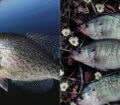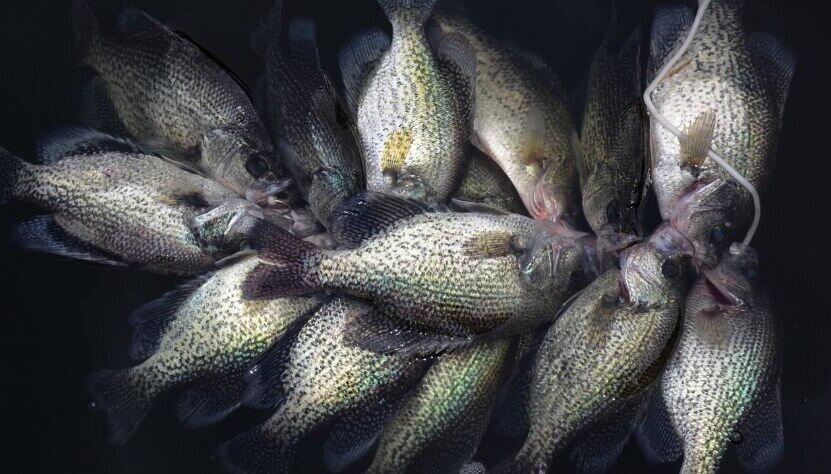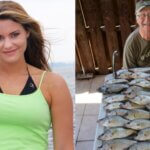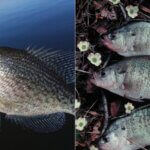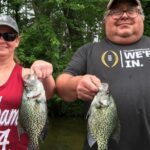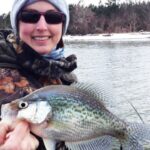Editor’s Note: Many sections of the U.S, particularly the South, have crappie on their shorelines now – the end of February and the month of March. This week we’ll learn more about how to fish for shoreline crappie. Instead of battling crowds, move-up small creeks and/or streams that feed major reservoirs where bigger boats can’t get to find outstanding early-spring crappie fishing on the shoreline.
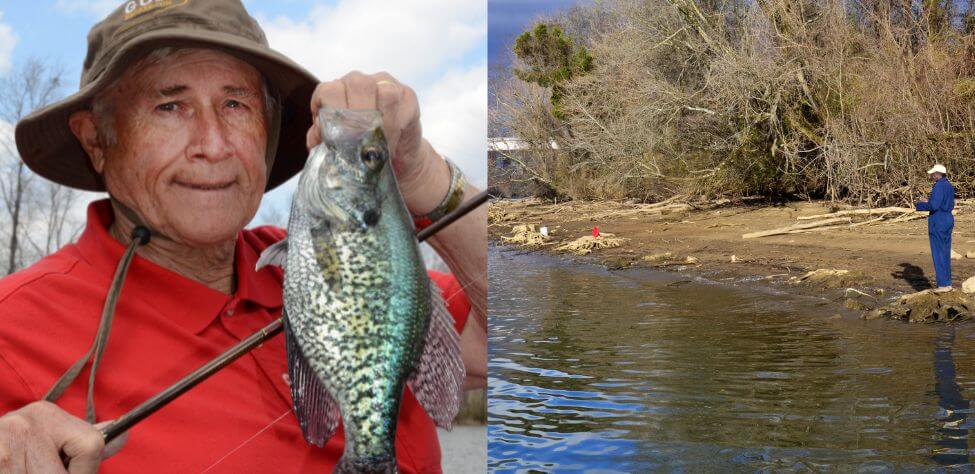
During the prespawn and the spawn, most of the major reservoirs throughout the nation will have a line of crappie-fishing boats around them resembling a bathtub ring. Like you, I’ve seen some lakes where so-many crappie anglers line the bank that you almost can step from one boat to another. You don’t have to be a rocket scientist to realize that with that much fishing pressure, each angler is catching fewer fish than he will if little or no fishing pressure is present.
Instead of battling the crowds, move-up small creeks and/or streams that feed these major reservoirs where bigger boats can’t go. You may not see another angler but may discover outstanding crappie fishing. Often these feeder creeks will hold the bigger spawners and sometimes large numbers of these fish. If these feeder streams are warm-water creeks, the crappie will appear in these regions first. By fishing from the bank, you’ll often catch a limit of slab-sized crappie quicker and easier than the anglers on the lake will.
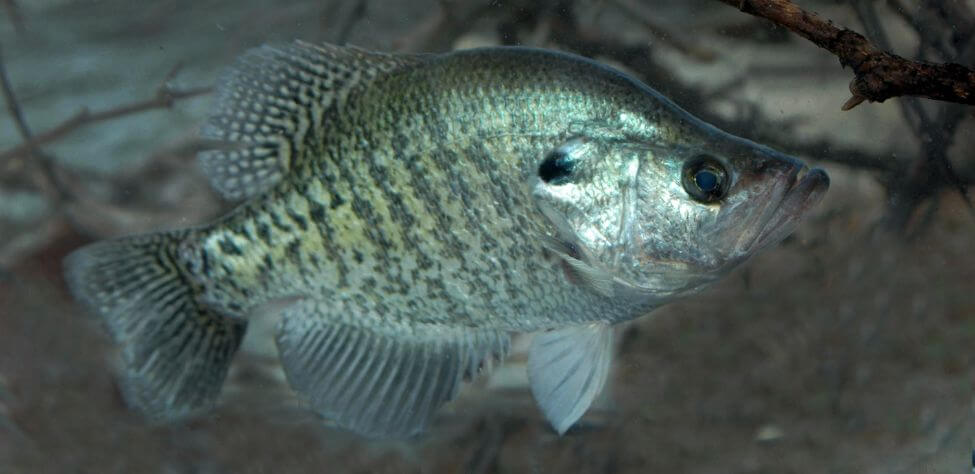
To pinpoint these little feeder streams, purchase lake maps of the best crappie lakes in your area. Look for the streams that feed the main creeks or flow into the main lake. Another way to find small streams full of crappie is to call the fisheries biologist with your state’s department of conservation. The biologists employed by the state generally have a good working knowledge of the kinds of fish to be found in small streams. Oftentimes they can tell you where the best access points are to these little waters.
You also can look for what I call blue-line crappie. When you buy a paper map of a state, the map’s blue lines usually denote minor roads – not big major roads. By identifying the two-lane roads and searching for those roads that have nearby creeks or streams on a map, you’ll pinpoint small waters to fish for crappie.
Tomorrow: How to Locate Government Crappie
Expert Guidebooks on Crappie Fishing: Best Sellers
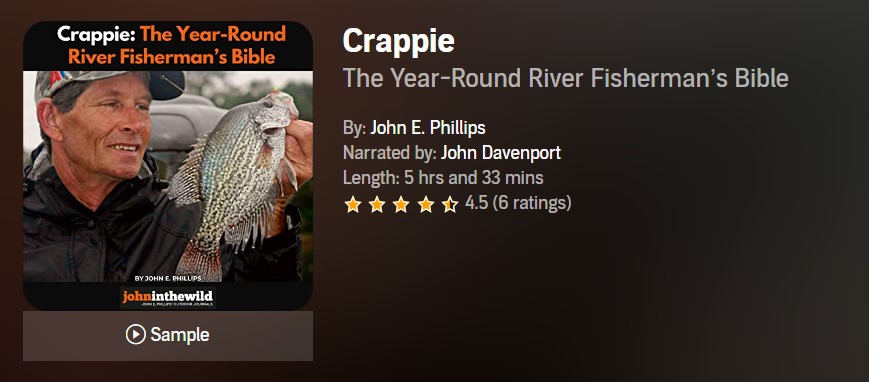
Fishing rivers for crappie and being able to find and catch speckled sides consistently has long been one of the mysteries in the crappie-fishing world.
“One of the reasons that river systems are so difficult to fish is because the water’s either rising or falling in them,” says Ott DeFoe, the 2019 Bassmaster Classic champion.
Rivers also are very susceptible to floods and droughts and constantly have current moving through them. Often fast current or slow current in rivers is created by rain or droughts upstream. When rivers flood, they can wash away fish habitat like logs, sunken trees, manmade brush piles and stake beds. But that’s the time when a river also creates new crappie hot spots that haven’t been available to the crappie or the fishermen before the flood.
Because river systems are so unpredictable, I’ve felt the best way to get the most useful information on how to fish rivers for crappie is to talk to numbers of anglers all over the nation to learn their best tactics.
In this book, I’ve gleaned crappie-fishing wisdom from three dozen crappie anglers and guides from a dozen states, who consistently catch crappie at all times of the year. The tournament crappie fishermen in this book fish most of the country at different times of the year on various river systems and lakes. And, these anglers use techniques you never may have considered, including:
- Setting up a casting ring with your electronics to keep you from getting too close to the crappie that are holding on underwater structure, while you’re fishing all the way around the structure;
- Buying an automotive laser temperature gauge to measure water temperature
- Evaluating the most-productive places to sink brush and other structure, according to prevailing wind direction, the crappie’s summer, fall, winter, and spring migration patterns, and other factors.
VERSIONS: AUDIBLE, KINDLE & PRINT
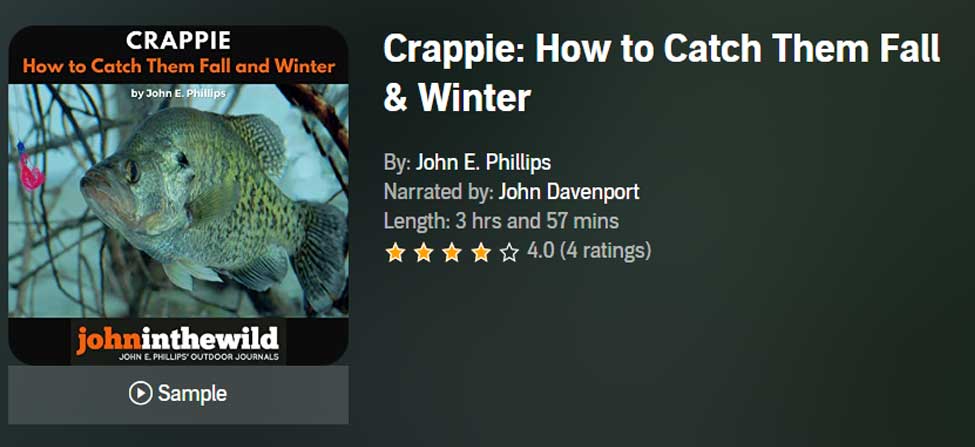
Crappie: How to Catch Them Fall & Winter
Yes, you can catch and eat crappie during the fall and winter months. Often, at many places, you’ll catch more and bigger crappies in the fall and winter than you do in the spring and summer. To learn where to find and how to catch cooler weather speckled sides, we’ve interviewed a wide variety of some of the nation’s best tournament crappie fishermen and guides.
Many of the individuals you’ll hear about in this audiobook are tournament crappie pros who travel the country to fish in crappie tournaments from New York to Florida and from Virginia to California. They use the latest crappie-finding equipment, the best poles, rods, reels, line, and the most-productive baits. Each of the people mentioned in this book has the ability to be dropped out of an airplane anywhere in the United States and catch crappie on any lake close to where they land that contains crappie.
From over 50 years of crappie-fishing experience, I’ve learned that you get the best advice by interviewing a large number of people who have different tactics and fish under various water, weather, and fishing-pressure conditions.
In this book, you will learn:
- How to spider-rig (slow-troll), which is one of the fastest-growing techniques for catching the most and biggest crappies in the shortest time
- How to catch crappie on crank baits and when and where using a crank bait is the most appropriate
- How to find areas of any lake that will hold large schools of crappies during the winter months – places you can return to time and again and expect them to be there
- Why competing in crappie tournaments is one of the quickest ways to learn how to catch more and bigger crappie faster
- Why and how to look for and catch the biggest crappie in a lake
VERSIONS: AUDIBLE, KINDLE & PRINT
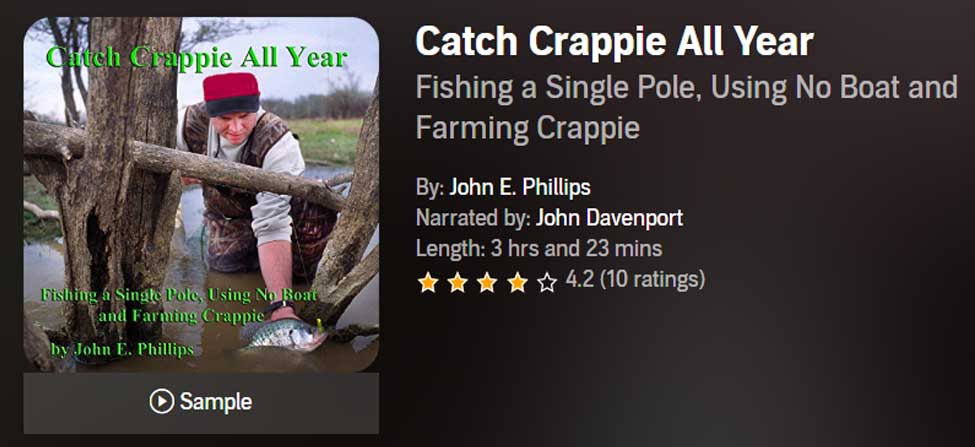
Catch Crappie All Year: Fishing a Single Pole, Using No Boat, and Farming Crappie
I’ve interviewed some of the best crappie fishermen in the nation for my new audiobook, Catch Crappie All Year: Fishing a Single Pole, Using No Boat and Farming Crappie to learn how, where, and when to catch the most crappie with or without a boat while single-pole fishing. I’ve also included information on how to grow a crop of crappie to catch every day of the year. Although I’ve fished in fully rigged crappie boats costing $45,000 – $90,000-plus that can have up to 16 rods at one time to slow troll, I still enjoy….
- Watching a quill cork sink in a brush top
- Fishing with an ultralight spinning rod
- Reeling jigs or minnows along a grass line and feeling that thud when a crappie takes the bait
- Fishing with family and friends, even if we all can’t fit in one boat
- Participating in less-expensive and hassle-free yet highly-productive crappie fishing like single poling
I’ve tried to capture in this new audiobook the old way of crappie fishing with new twists and detailed tactics to aid you in catching crappie all year.
VERSIONS: AUDIBLE, KINDLE & PRINT
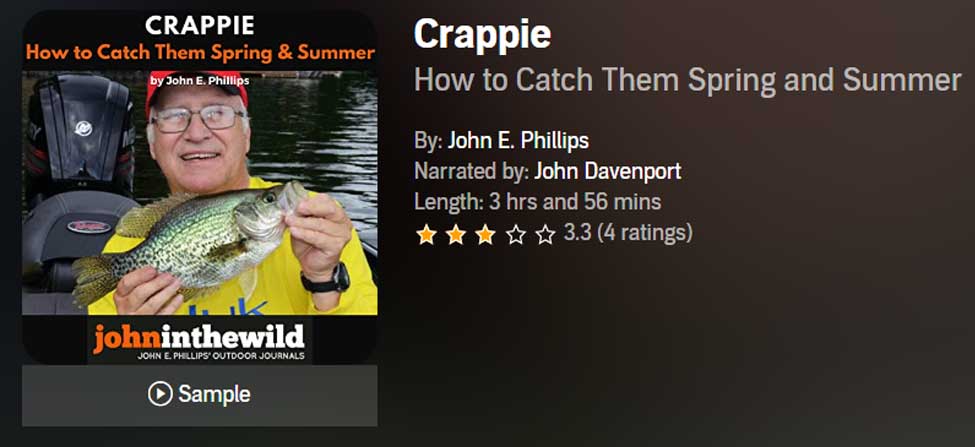
Crappie: How to Catch Them Spring and Summer
You can catch crappie all year long if you know where to find them and what techniques to use to catch them. However, crappie fishing is so technical these days, and we’ve learned so much about how to crappie fish because of the professional crappie-fishing circuits, that one book can’t hold all the information.
This book is the first of a three-part series on how, where, and when to catch crappie, with the best crappie fishermen in the nation. Many of these men have proven they are the best, because they’ve won crappie-fishing tournaments or been successful fishing guides for many years.
This audio version of Crappie: How to Catch Them Spring and Summer includes crappie pros like Ronnie Capps, who has won seven national championships and over $1 million with his partner Steve Coleman.
We also have Malcolm Lane, Stokes McClellan from North Carolina, Billy Blakeley from Reelfoot Lake, John Woods, Kent Driscoll, fishing biologist and professional basser Ken Cook, and many others. We asked the questions that crappie fishermen want answered about how to find and catch crappie during the spring and summer months, and these fishing tips are the result.
In the world of crappie fishing, no one man knows it all, and that’s why I’ve interviewed so many fishermen, asked so many questions, and tried to get so many answers for you about how to fish.
VERSIONS: AUDIBLE, KINDLE & PRINT

